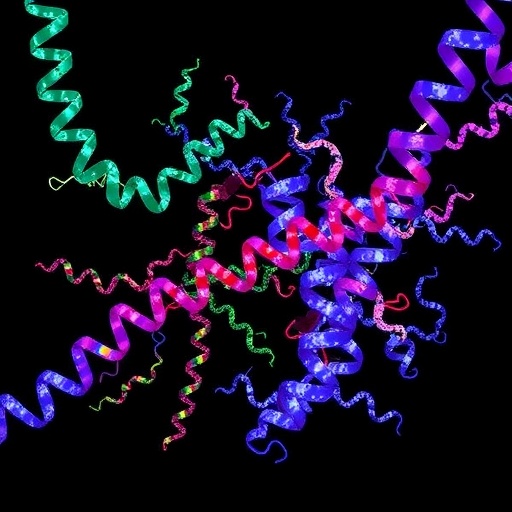Revolutionizing our understanding of chromatin interactions, a groundbreaking study led by Zhou et al. reveals a new statistical framework designed to detect differential chromatin interactions from high-resolution pseudo-bulk Hi-C data. This innovative approach, dubbed PB-DiffHiC, unlocks new potentials in genomic research by offering unprecedented accuracy and detail in analyzing chromatin structure and function—critical factors in gene regulation, cellular development, and disease progression. The implications of this research reach far beyond basic science, holding promise for advancements in clinical applications, such as cancer treatment and genetic disorders.
The core of the PB-DiffHiC framework lies in its sophisticated statistical modeling designed to enhance the analysis of chromatin interactions. Historically, the study of chromatin has been hampered by limitations in resolution and sensitivity when analyzing high-throughput data. High-resolution Hi-C techniques, which map the spatial organization of the genome, generate an enormous amount of data, but extracting biologically relevant insights from this data remains challenging. The PB-DiffHiC model addresses these issues, providing a robust statistical toolkit that can cope with the complexity of genomic data while providing reliable results.
What makes PB-DiffHiC particularly exciting is its ability to identify differences in chromatin interactions across different conditions or cell types. Traditional methods often overlook subtle yet biologically significant changes, but the new framework is engineered to detect these nuanced variations within complex datasets. By leveraging a pseudo-bulk approach, the researchers maximize the utility of available data, resulting in enhanced power to distinguish true biological differences from noise—a critical challenge in genomic analysis.
In the study, Zhou and colleagues applied the PB-DiffHiC framework to a variety of datasets, demonstrating its versatility and efficacy. They offer compelling examples illustrating how the framework not only improves detection rates of differential interactions but also refines our understanding of the underlying biological processes. For instance, by applying the PB-DiffHiC tool to cancer cell lines, the researchers could pinpoint chromatin interaction shifts that correlate with malignant transformation, shedding light on potential new therapeutic targets.
Moreover, the framework includes user-friendly features tailored for researchers with varying levels of statistical expertise. By providing intuitive visualizations and interpretations of results, PB-DiffHiC serves as an accessible tool for scientists from various disciplines. This democratization of advanced statistical methods in genomic research signals a shift toward more inclusive scientific inquiry, allowing researchers to harness the power of advanced analytics without needing extensive training in statistics.
As the scientific community navigates the complexities of epigenetic regulation, the introduction of PB-DiffHiC is poised to significantly reshape our approach to studying chromatin dynamics. Understanding how chromatin structure influences gene expression could pave the way for novel approaches to disease prevention and treatment. The ramifications of this research extend to fields such as developmental biology, neuroscience, and immunology, where chromatin organization plays a pivotal role in cell identity and functional capacity.
In addition, the implications of the PB-DiffHiC framework extend to agricultural and environmental sciences. As researchers seek to understand the genetic basis of traits in crops or the response of organisms to environmental stressors, the ability to discern differential chromatin interactions offers a powerful avenue for discovery. The potential to improve crop resilience or yield through genetic manipulation becomes increasingly feasible with such advanced tools at our disposal.
The adoption of PB-DiffHiC could also catalyze further innovations in the field of genomics. With the demand for high-resolution data analysis growing, tools like PB-DiffHiC are vital for translating raw data into actionable biological insights. Through collaboration and continued refinement of these methodologies, scientists can expand our understanding of genetic regulation and its pervasive impact on health and disease.
Future studies employing the PB-DiffHiC framework could offer insights into the long-term dynamics of chromatin interactions across development or in response to therapy, providing a rich avenue for exploration. As researchers grapple with the intricate web of regulatory elements within the genome, the capabilities of PB-DiffHiC may prove essential for unlocking the code of genetic expression. Cross-disciplinary collaboration will be key to maximizing the framework’s potential, as experts in computational biology, statistics, and genetics come together to tackle complex biological questions.
As science continues to advance, the research community stands at the forefront of a genomics revolution. Zhou et al.’s development of the PB-DiffHiC framework positions researchers to explore the unexplored territories of chromatin interactions with newfound clarity. This is not merely a scientific advancement—it’s a message of hope for many patients who are waiting for breakthroughs in therapies derived from a deeper understanding of genetics.
The incorporation of such comprehensive tools into routine research practices can lead to more consistent and reproducible results, a necessity in the pursuit of scientific rigor. With a commitment to embracing innovative methodologies like PB-DiffHiC, the field of genomics is poised for an exciting era of discovery, where data holds the key to understanding life’s most fundamental processes.
In summary, PB-DiffHiC represents a major leap forward in chromatin research, allowing for the detection of subtle alterations that could have significant biological implications. As this framework gains traction, its contributions will likely shape the next generation of genomic research, leading to transformational breakthroughs across scientific disciplines. The potential for PB-DiffHiC to uncover the mysteries of chromatin interactions is vast, and its impact on science and medicine promises to be extensive.
Subject of Research: Differential Chromatin Interactions
Article Title: PB-DiffHiC: a statistical framework for detecting differential chromatin interactions from high resolution pseudo-bulk Hi-C data
Article References:
Zhou, Y., Hu, Y., Tan, L. et al. PB-DiffHiC: a statistical framework for detecting differential chromatin interactions from high resolution pseudo-bulk Hi-C data.
BMC Genomics 26, 900 (2025). https://doi.org/10.1186/s12864-025-11987-y
Image Credits: AI Generated
DOI: 10.1186/s12864-025-11987-y
Keywords: chromatin interactions, PB-DiffHiC, high-resolution Hi-C, genomic research, statistical framework, gene regulation, cancer, statistical modeling, epigenetics, data analysis.
Tags: advancements in cancer treatmentcellular development insightschallenges in high-throughput genomic datachromatin structure and functiondifferential chromatin interactionsdisease progression researchgene regulation mechanismsgenetic disorders and chromatin interactionshigh-resolution Hi-C data analysisinnovative approaches to genomic researchPB-DiffHiC frameworkstatistical modeling in genomics






